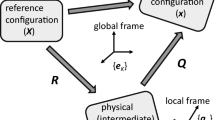Abstract
An examination of the time to failure for uniaxial tensile specimens of some 50 materials, measured in some cases over test decades of time, has suggested a universal rate relation between lifetime, stress, and temperature of the form τ = τo exp [(Uo - γσ)/kT]. The constant τo is essentially the reciprocal of the natural oscillation frequency of atoms in the solid, Uo is the binding energy on the atomic scale, and γ is proportional to the disorientation of the molecular structure. Assuming the kinetic nature of bond destruction through the thermofluctuation mechanism, direct experimental verification of the phenomenon for polymers has been obtained using electron paramagnetic resonance.
Résumé
Un examen du temps de rupture pour des échantillons de traction uniaxes d'environ 50 matériaux, mesuré dans certains cas sur 10 décades de temps, a suggéré une relation universelle entre la durée de la résistance, la traction et la température, de la forme: τ = τo exp [(Uo - γσ)/kT] La constante τo est essentiellement la réciproque de la fréquence naturelle d'oscillation des atomes dans le solide, Uo est l'énergie de liaison des atomes et γ est proportionnel à la désorientation de la structure moléculaire. En admettant la nature cinétique de la destruction de la liaison, par le mécanisme de fluctuation thermique, la vérification expérimentale directe du phénomène à été obtenue, pour des polymères, par la technique de la résonance paramagnétique des électrons.
Zusammenfassung
Eine Betrachtung der Bruchzeit von einachsigen Spannungsprüflingen aus ungefähr 50 verschiedenen Materialien gemessen in manchen Fällen über zehn Zeitdekaden, lässt einen allgemeinen Zusammenhang zwischen der Zeit bis zum Bruch (lifetime), der Zugspannung und der Temperatur, der Form τ = τo exp [(Uo - γσ)/kT] vermuten.
Die Konstante τo ist im wesentlichen die reziproke natürliche Schwingungsfrequenz der Atome im Festkörper, Uo ist die bindungsenergie zwischen den Atomen, und γ ist proportional des Disorientierung der molekularen Struktur. Unter der Annahme, dass die Bindungszerstörung kinetischer Natur ist und durch Thermofluktuation erfolgt, wurde eine direkte experimentelle Bestätigung der Zusammenhänge bei Polymeren durch Beobachtung der paramaguetischen Elcktronenresonanz erhalten.
Similar content being viewed by others
References
S.N. Zhurkov and E. E. Tomashevsky, “Investigation of the strength of solids”, Zhum. Teklin. Fiz.,XXV, 66 (1955).
S.N. Zhurkov and B.I. Narzulayev, “The time dependence of the strength of solids”, Zhurn.Teklun. Fiz.,XXIII, 1677 (1953).
S.N. Zhurkov, “Das Problem der Festigkeit fester Körper”, Z. für Phys.Chemie.213, 183 (1960).
S.N. Zhurkov, B.Ya. Levin and T.P. Sanfirova “The temperature and time dependence of the strength of silver chloride”, Fiz.Tv.Tela, 2, 1033 (1960).
S.N. Zhurkov and T.P. Sanfirova, “The temperature and time dependence of the strength of pure metals”, Dokl.Akad.Nauk SSSR,101, 237 (1955).
S.N. Zhurkov, “The problem of the strength of solids”, Vestnik Akad.Nauk SSSR,11, 78 (1951).
S.N. Zhurkov and S.A. Abasov, “The relation between mechanical strength and thermal destruction of polymers”, Vysokomol.soyedineniya,4, 1703 (1962).
S.N.Zhurkov, V.I.Detekhtin and A.I. Slutsker “The disorientation of blocks and the strength of metals”, Fiz. Tv.Tela.5, (1963).
S.N. Zhurkov and E.E. Tomashevsky, “A microscopic study of crack growth in fracture”, Zhum. Tekhn. Fiz.,XXVII, 1248 (1957).
A. Tobolsky and H. Eyring, “Mechanical properties of polymeric materials”, J. Chem. Phys.,11, 125 (1943).
F. Bueche, “Tensile strength of plastics below the glass temperature”, J. Appl. Phys.28, 784 (1957).
A.I. Gubarov and A.D. Chevychelov, “On the theory of tensile strength of solids”, Fiz. Tv. Tela,4, 928 (1962).
S.E. Bresler, S.N.Zhurkov, E.N. Kozbekov, E.M.Sominsky and E.E. Tomashevsky “Investigation of macroradicals forming in mechanical destructionof polymers”, Zhurn. Tekhn. Fiz.,XXIX, 358 (1959).
S.N. Zhurkov, E.E.Tomashevsky and V.A. Zakrevsky, “Investigation of macroradicals forming in mechanical destruction of polymers”. Fiz. Tv. Tela,3, 2841 (1961).
S.N. Zhurkov, A.Ya. Savostin and E.E. Tomashevsky, “Investigation of the mechanism of fracture in polymers by the EPR-method”, Dokl. Akad. Nauk USSR,159, 303 (1964).
Author information
Authors and Affiliations
Additional information
Invited lecture presented at the International Conference on Fracture, Sendai. Japan, Sept. 1965.
Rights and permissions
About this article
Cite this article
Zhurkov, S.N. Kinetic concept of the strength of solids. Int J Fract 26, 295–307 (1984). https://doi.org/10.1007/BF00962961
Received:
Issue Date:
DOI: https://doi.org/10.1007/BF00962961



